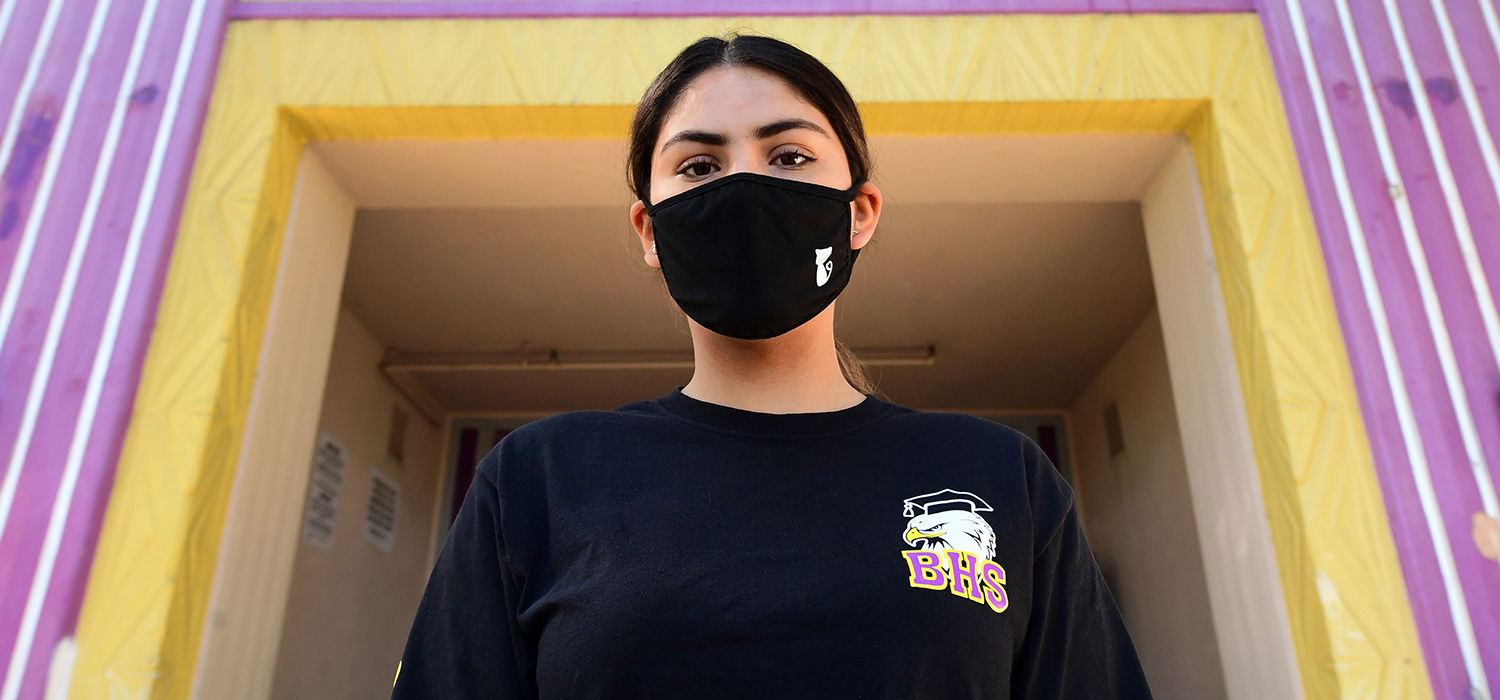
<p>Bell High School senior Kenia Molina in front of campus in Bell, California on April 15, 2020, which remains closed due to the coronavirus pandemic as students continue teir education via remote learning. - As a member of the 2020 "class of coronavirus," Kenia Molina needed to find a laptop in order to graduate high school-- a technology gap that has caused thousands of poorer students to miss out on weeks of education. With nearly all US schools and universities shut for the academic year, the Los Angeles student has had to complete her final year via virtual learning on a home computer she was donated by her district. "This is really important... for students that don't have any access to the internet or even have any devices that they can't even afford," said Molina, wearing a protective mask and glove as she collected her laptop. (Photo by FREDERIC J. BROWN/AFP via Getty Images)</p>
As the nation navigates an unprecedented shift to online learning, standardized test data show students without computer or internet access are already far behind their peers in reading and math achievement.
These gaps are likely to be exacerbated by remote learning. Federal policymakers, philanthropists, and internet providers looking to mitigate the negative effects of distance learning can use student survey data from the National Assessment of Educational Progress (NAEP) to target state-level investments, and state policymakers and district leaders can consider collecting similar data on a local level. Continued data collection—especially on the 2021 NAEP, if possible—will be critical for understanding the effects of this sweeping change on student outcomes.
Students without internet or computer access are already behind academically
The NAEP is a biennial test given to a representative sample of 4th and 8th graders in all 50 states, and NAEP scores are one of the primary benchmarks education stakeholders use to track and compare American students’ academic performance. The administration of the NAEP is accompanied by a survey, which, in 2019, asked students to report their access to the internet and a computer (desktop, laptop, and/or tablet) in the home.
Access to online resources increases with age; among 8th graders who completed the survey last year, 89 percent reported having access to the internet and a computer, compared with 81 percent of 4th graders.
Although a smaller share of students lack access to technology in 8th grade compared with 4th grade, the digital achievement gap is wider for older students. Students with full access to technology scored at least half a standard deviation higher on the NAEP, relative to those without access. This is the equivalent (PDF) of roughly 9 and 14 months of learning, for 4th grade math and reading, respectively, and about 27 months of learning in 8th grade. This achievement gap is large but slightly smaller than the gap between those who are identified as eligible for the National School Lunch (NSL) program and those who were not (the NSL gap ranges from 0.66 to 0.75 standard deviations).

Access to the internet and a computer is strongly correlated with family income and other factors, such as local internet infrastructure. In 2018, 17 percent of children ages 5 to 17 lived in poverty in the United States. Though the share of 8th grade students who report limited technology access (11 percent) is lower than the national poverty rate, students with limited technology are more likely to be low income.
The achievement gap is wider in states where a small share of students lack technology access
States with relatively high student access to technology should not assume the digital divide is less of a concern in their state. In contrast, we find that the size of the NAEP achievement gap generally increases as technology coverage increases.

For example, Massachusetts, which posted the highest 8th grade math scores on the 2019 NAEP, also reported the highest percentage of 8th graders with access to the internet and a computer at home (93 percent, tied with New Jersey). However, the small number of 8th graders surveyed in Massachusetts without access to a device and/or the internet at home are, on average, more than 40 months of learning behind their peers with technology.
Students without remote learning access in high-access states, like Massachusetts, are at a higher risk of poor academic performance as schools switch to remote learning. Lack of technology in the home will likely exacerbate the issue when the ability to “attend” school relies on the availability of a computer and a reliable internet connection.
Future NAEP assessments will provide insights into changes in digital access and achievement gaps
Though many school districts are trying to remedy gaps in access to remote learning, the NAEP assessments in early 2021 could help us understand the effect of the COVID-19 pandemic on these student outcomes. These achievement data will only be useful with the student survey, which allows us to understand the student’s home context.
In 2019, however, six states opted out of the survey: Alaska, Colorado, Montana, New Hampshire, South Dakota, and Utah. We don’t have home technology information for these states, and policymakers will not have a baseline for assessing future technology achievement gaps.
State agencies face many challenges at the moment. If the main NAEP can be administered in the winter and spring of 2021, these assessments should be a priority for state education agencies. States should ensure their NAEP students take the accompanying survey and should push for new questions related to COVID-19. These questions could help states and districts understand how students received instruction during the pandemic and identify the long-term challenges in remediating remote learning loss.
Let’s build a future where everyone, everywhere has the opportunity and power to thrive
Urban is more determined than ever to partner with changemakers to unlock opportunities that give people across the country a fair shot at reaching their fullest potential. Invest in Urban to power this type of work.